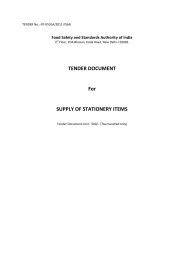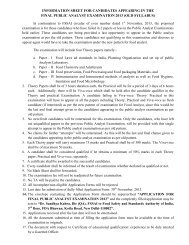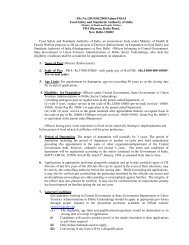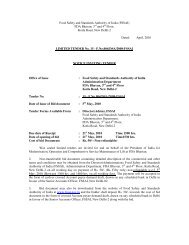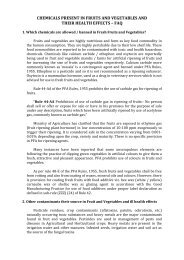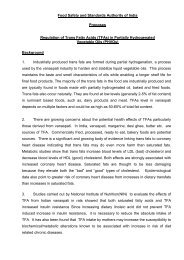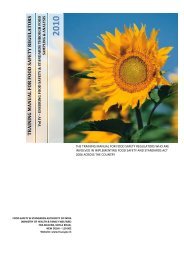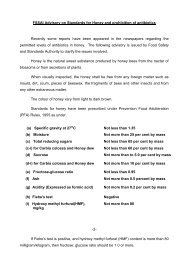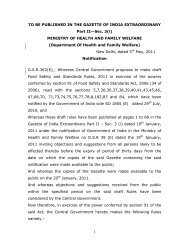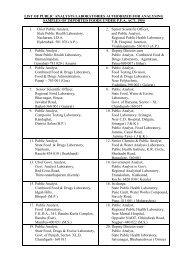codex general standard for contaminants and toxins in food and feed
codex general standard for contaminants and toxins in food and feed
codex general standard for contaminants and toxins in food and feed
Create successful ePaper yourself
Turn your PDF publications into a flip-book with our unique Google optimized e-Paper software.
2 Codex St<strong>and</strong>ard 193-19951.2.4 Maximum level <strong>and</strong> related terms 2The Codex maximum level (ML) <strong>for</strong> a contam<strong>in</strong>ant <strong>in</strong> a <strong>food</strong> or <strong>feed</strong> commodity is the maximum concentration of thatsubstance recommended by the Codex Alimentarius Commission (CAC) to be legally permitted <strong>in</strong> that commodity.1.3 PRINCIPLES REGARDING CONTAMINANTS IN FOOD AND FEED1.3.1 GeneralContam<strong>in</strong>ation of <strong>food</strong> <strong>and</strong> <strong>feed</strong> may pose a risk to human (<strong>and</strong>/or animal health). Moreover <strong>in</strong> some cases they mayalso have a negative impact on the quality of the <strong>food</strong> or <strong>feed</strong>. Food <strong>and</strong> <strong>feed</strong> can become contam<strong>in</strong>ated by variouscauses <strong>and</strong> processes.Contam<strong>in</strong>ant levels <strong>in</strong> <strong>food</strong> <strong>and</strong> <strong>feed</strong> shall be as low as reasonably achievable through best practice such as GoodAgricultural Practice (GAP) <strong>and</strong> Good Manufactur<strong>in</strong>g Practice (GMP) follow<strong>in</strong>g an appropriate risk assessment. Thefollow<strong>in</strong>g actions may serve to prevent or to reduce contam<strong>in</strong>ation of <strong>feed</strong> <strong>and</strong> <strong>food</strong> 3 :- prevent<strong>in</strong>g <strong>food</strong> <strong>and</strong> <strong>feed</strong> contam<strong>in</strong>ation at the source, e.g. by reduc<strong>in</strong>g environmental pollution.- apply<strong>in</strong>g appropriate technology control measure(s) <strong>in</strong> <strong>food</strong> <strong>and</strong> <strong>feed</strong> production, manufacture,process<strong>in</strong>g, preparation, treatment, pack<strong>in</strong>g, packag<strong>in</strong>g, transport or hold<strong>in</strong>g.- apply<strong>in</strong>g measures aimed at decontam<strong>in</strong>ation of contam<strong>in</strong>ated <strong>feed</strong> or <strong>food</strong> <strong>and</strong> measures to preventcontam<strong>in</strong>ated <strong>feed</strong> or <strong>food</strong> to be marketed <strong>for</strong> consumption.To ensure that adequate action is taken to reduce contam<strong>in</strong>ation of <strong>food</strong> <strong>and</strong> <strong>feed</strong> a Code of Practice shall be elaboratedcompris<strong>in</strong>g source related measures <strong>and</strong> Good Manufactur<strong>in</strong>g Practice as well as Good Agricultural Practice <strong>in</strong> relationto the specific contam<strong>in</strong>ation problem.The degree of contam<strong>in</strong>ation of <strong>food</strong> <strong>and</strong> <strong>feed</strong> <strong>and</strong> the effect of actions to reduce contam<strong>in</strong>ation shall be assessed bymonitor<strong>in</strong>g, survey programs <strong>and</strong> more specialized research programs, where necessary.When there are <strong>in</strong>dications that health hazards may be <strong>in</strong>volved with consumption of <strong>food</strong> that is contam<strong>in</strong>ated, it isnecessary that a risk assessment should be undertaken. When health concerns can be substantiated, a riskmanagement measure must be applied, based on a thorough evaluation of the situation <strong>and</strong> consideration of a range ofrisk management options. Depend<strong>in</strong>g on the assessment of the problems <strong>and</strong> the possible solutions, it may benecessary to establish MLs or other measures to control the contam<strong>in</strong>ation of <strong>food</strong> <strong>and</strong> <strong>feed</strong>. In special cases, specificadvice on dietary recommendations may also have to be considered to complement other regulatory measures, whenthe measures are not sufficiently adequate to protect public health <strong>and</strong> safety.National measures regard<strong>in</strong>g <strong>food</strong> <strong>and</strong> <strong>feed</strong> contam<strong>in</strong>ation should avoid the creation of unnecessary barriers to<strong>in</strong>ternational trade <strong>in</strong> <strong>food</strong> <strong>and</strong> <strong>feed</strong> commodities. The purpose of the GSCTFF is to provide guidance about possibleapproaches to elim<strong>in</strong>ate or reduce the contam<strong>in</strong>ation problem <strong>and</strong> to promote <strong>in</strong>ternational harmonization throughrecommendations which <strong>in</strong> turn may prevent trade barriers <strong>and</strong> disputes.For all <strong>contam<strong>in</strong>ants</strong>, which may be present <strong>in</strong> more than one <strong>feed</strong> or <strong>food</strong> item, a broad approach shall be applied,tak<strong>in</strong>g <strong>in</strong>to account all relevant <strong>in</strong><strong>for</strong>mation that is available, <strong>for</strong> the assess<strong>in</strong>g of risks <strong>and</strong> <strong>for</strong> develop<strong>in</strong>grecommendations <strong>and</strong> control measures, <strong>in</strong>clud<strong>in</strong>g the sett<strong>in</strong>g of maximum levels.1.3.2 Pr<strong>in</strong>ciples <strong>for</strong> establish<strong>in</strong>g maximum levels <strong>in</strong> <strong>food</strong> <strong>and</strong> <strong>feed</strong>MLs shall only be set <strong>for</strong> <strong>food</strong> <strong>in</strong> which the contam<strong>in</strong>ant may be found <strong>in</strong> amounts that are significant <strong>for</strong> the totalexposure of the consumer, tak<strong>in</strong>g <strong>in</strong>to consideration the Policy of the Codex Committee on Contam<strong>in</strong>ants <strong>in</strong> Foods <strong>for</strong>Exposure Assessment of Contam<strong>in</strong>ants <strong>and</strong> Tox<strong>in</strong>s <strong>in</strong> Foods or Food Groups (Section III of the Procedural Manual).The maximum levels shall be set <strong>in</strong> such a way that the consumer is adequately protected. At the same time the otherlegitimate factors need to be considered. This will be per<strong>for</strong>med <strong>in</strong> accordance with the “Work<strong>in</strong>g pr<strong>in</strong>ciples <strong>for</strong> RiskAnalysis <strong>for</strong> Food safety <strong>for</strong> Application by Governments”.The pr<strong>in</strong>ciples of Good Manufactur<strong>in</strong>g Practice <strong>and</strong> Good Agricultural Practice as def<strong>in</strong>ed by Codex shall be used.Maximum levels shall be based on sound scientific pr<strong>in</strong>ciples lead<strong>in</strong>g to levels which are acceptable worldwide, so thatthere is no unjustified barrier to <strong>in</strong>ternational trade. MLs shall be clearly def<strong>in</strong>ed with respect to status <strong>and</strong> <strong>in</strong>tended use.1.3.3 Specific criteriaThe follow<strong>in</strong>g criteria should (not prevent<strong>in</strong>g the use of other relevant criteria) be considered when develop<strong>in</strong>g MLs<strong>and</strong>/or other measures <strong>in</strong> connection with the Codex General St<strong>and</strong>ard <strong>for</strong> Contam<strong>in</strong>ants <strong>and</strong> Tox<strong>in</strong>s <strong>in</strong> Food <strong>and</strong> Feed:(Further details about these criteria are given <strong>in</strong> Annex I).Toxicological <strong>in</strong><strong>for</strong>mation- identification of the toxic substance(s);- metabolism by humans <strong>and</strong> animals, as appropriate;23For the <strong>contam<strong>in</strong>ants</strong> methylmercury, radionuclides, acrylonitrile <strong>and</strong> v<strong>in</strong>ylchloride monomer a Codex guidel<strong>in</strong>e level (GL) has been established.A Codex guidel<strong>in</strong>e level (GL) is the maximum level of a substance <strong>in</strong> a <strong>food</strong> or <strong>feed</strong> commodity which is recommended by the CAC to beacceptable <strong>for</strong> commodities mov<strong>in</strong>g <strong>in</strong> <strong>in</strong>ternational trade. When the GL is exceeded, governments should decide whether <strong>and</strong> under whatcircumstances the <strong>food</strong> should be distributed with<strong>in</strong> their territory or jurisdiction.Because the CAC has decided that the preferred <strong>for</strong>mat of a Codex <strong>st<strong>and</strong>ard</strong> <strong>in</strong> <strong>food</strong> or <strong>feed</strong> is a maximum level, the present exist<strong>in</strong>g or proposedguidel<strong>in</strong>e levels shall be reviewed <strong>for</strong> their possible conversion to a maximum level after a risk assessment per<strong>for</strong>med by JECFA, if appropriate.In addition, reference is made to the Code of Practice <strong>for</strong> source Directed measures to reduce contam<strong>in</strong>ation of <strong>food</strong> with chemicals (CAC/RCP 49-2001) <strong>and</strong> the Code of Practice on Good Animal Feed<strong>in</strong>g (CAC/RCP 54-2004).



